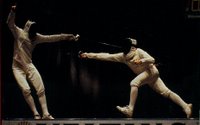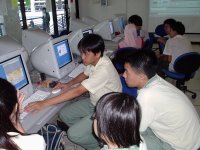Revolutionizing Learning in the Digital Age
The day will come, as predicted by Isaac Asimov, when human beings cannot live without computers; when computers will become as ubiquitous as the cell phones. Many strongly believe that computers will have a great influence in revolutionizing learning. According to Resnick, the time has come for humans to not only know how to use digital technology but to know how to construct ‘things of significance with digital technology’. To be digitally fluent will become a ‘prerequisite for obtaining jobs’.
It is said that today’s adolescents have grown up with technology (1 to 1 Learning, 2006). Technology is indeed a driving force behind globalization and is vital in teaching and learning. With the change in goals/philosophy and pedagogy, student’s work is more customized, more self-directed and collaborative. As advocated by Kozma, technology facilitates the increased usage of online learning to meet instructional goals. Resources must be made available to students anytime, and from anywhere. Rather than using technology merely to communicate via emails or chat rooms, technology should be harnessed further by developing a network of a community of practice – students, teachers and experts. Here, students will be able to consult a pool of experts in the various fields to discuss related issues or to verify some learning points. These experts are seen as good role models for the students. We should also engage companies to be involved in the education of our young as part of the total learning environment. These companies can invest some of their professional employees' time in 'educational outreach' activities. They can take students from schools; give them hands-on experiences and interesting them in real world technologies. This is one way where we can develop stronger links between the academia and industry, society and government.
Resnick urged for a creative society, where success in the future will be based on our ability to think and act creatively. He believed that the Internet will enable ‘knowledge-building communities’ in which both adults and students around the world can collaborate on projects. An example is Singapore’s Pioneer Secondary School portal (http://www.pioneerss.moe.edu.sg/index.asp) that hosted Project iBox. The portal has various functions like file sharing, notice board, photo album, team planner, discussion board and a chat room. It also provides facilities for schools to upload their project details and share their views about each others' projects. The chat facility enables students to meet and share information such as the racial interactions in New Zealand (Whites vs. Maoris) and about racial integration in Singapore. Technology is thus able to bridge the world, enabling students from both sides of the Pacific Ocean to interact, collaborate and learn from different perspectives.
Just like Mike Lee who spent much time ‘hanging out’ at the Boston Computer Clubhouse to explore his creative side, we too should spend more time in coming up with new ideas and entrepreneurial approaches to teaching and learning using technology. Computers must do more than finger painting; it must provide the opportunity for students to not only design and create but to construct their own knowledge through active exploration.
1 to 1 Learning. A Review and Analysis by the Metiri Group. Course documents. Retrieved October 18, 2006 from EdT471-06. Lehigh University Blackboard, from http://ci.lehigh.edu/webapps/portal/frameset.jsp?tab=courses&url=/bin/common/course.pl?course_id=_10261_1
Kozma, R. (1994). Will media influence learning? Reframing the debate. Educational Technology, Research and Development, 42(2), 7-19.
Pioneer Secondary School’s portal. Retrieved October 19, 2006, from http://www.pioneerss.moe.edu.sg/index.asp
Resnick, M. (2001). Revolutionizing Learning in the Digital Age. Publications from the Forum for the Future of Higher Education. Boulder, CO: Educause.









